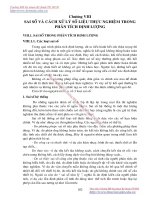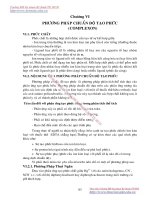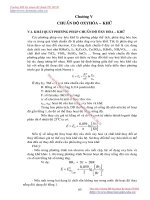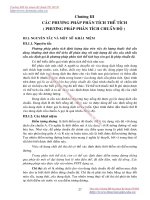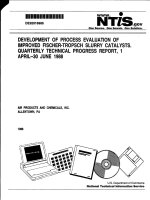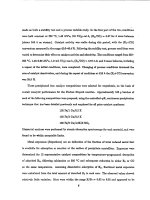Phân tích và dự báo
Bạn đang xem bản rút gọn của tài liệu. Xem và tải ngay bản đầy đủ của tài liệu tại đây (1.94 MB, 133 trang )
PRODUCTION ANALYSIS
AND FORECAST
Dr. Mai Cao Lan, HCMUT
August, 2017
Outline
An Overview of Petroleum Production System
(PPS) and the Nodal Analysis Method for PPS
Analysis of Reservoir Performance
Analysis of Wellbore Performance
Analysis of Choke & Flowline Performance
Analysis of Petroleum Production System
8/21/2017
Dr. Mai Cao Lân, Faculty of Geology & Petroleum Engineering, HCMUT, Vietnam
2
Text Books
Michael J. Economides et al. (1994). Petroleum
Production Systems. Petroleum Engineering
Series. Prentice Hall.
H. Beggs (2003). Production Optimization using
Nodal Analysis. OCGI & Petroskills Publications.
Mukherjee & Brill (1999). Multiphase Flow in
Wells. Society of Petroleum Engineers.
8/21/2017
Dr. Mai Cao Lân, Faculty of Geology & Petroleum Engineering, HCMUT, Vietnam
3
OVERVIEW OF
PETROLEUM PRODUCTION
SYSTEM & NODAL ANALYSIS
METHOD
8/21/2017
Dr. Mai Cao Lân, Faculty of Geology & Petroleum Engineering, HCMUT, Vietnam
4
Petroleum Production System
Gas Sales
Flowing Wellhead
Pressure
Horizontal Flowline
Separator
Stock Tank
Vertical or Inclined
Tubing
Intake
8/21/2017
Flow Through
Porus Media
P, K, IPR
Dr. Mai Cao Lân, Faculty of Geology & Petroleum Engineering, HCMUT, Vietnam
5
System Analysis for Petroleum
Production Systems
• Analyze the performance of the system taking into
account ALL of its components
• Figure out potential problems associated with the
production system
• Analyze the behavior of the system in response to
any changes of a component
8/21/2017
Dr. Mai Cao Lân, Faculty of Geology & Petroleum Engineering, HCMUT, Vietnam
6
NODAL Analysis (NA) Method
• NODAL Analysis belongs to System Analysis
Methods applied in Petro Eng.
• The method allows production engineers to
analyze the performance of a petroleum
production system
• The method help production engineers to
select optimal system parameters
8/21/2017
Dr. Mai Cao Lân, Faculty of Geology & Petroleum Engineering, HCMUT, Vietnam
7
Fundamentals of the NA Method
• Always consider a component in the relationships
with the others
• Pressure and Pressure Losses across different
components of the system are of primary
interests
• The performance of a system can be analyzed via
one or more NODEs
8/21/2017
Dr. Mai Cao Lân, Faculty of Geology & Petroleum Engineering, HCMUT, Vietnam
8
Possible Pressure Losses
Gas Sales
P8
Pwh
P6
Psep
P5
PDSV
Separator
Stock Tank
P4
PUSV
P1 = (Pr - Pwfs)
P2 = (Pwfs - Pwf)
P3 = (P UR - P DR)
P4 = (P USV - P DSV)
P5 = (Pwh - P DSC)
P6 = (P DSC - Psep)
P7 = (Pwf - Pwh)
P8 = (Pwh - Psep)
P7
PDR
P3
= Loss in Porus Medium
= Loss across Completion
= Loss across Restriction
= Loss across Safety Valve
= Loss across Surface Choke
= Loss in Flowline
= Total Loss in Tubing
= Total Loss in Flowline
PUR
Pwf
P2
Pwfs
Pr
P1
8/21/2017
Dr. Mai Cao Lân, Faculty of Geology & Petroleum Engineering, HCMUT, Vietnam
9
Locations of Various Nodes
1A
2
3
1
4
1B
5
6
8/21/2017
7
Node
Location
1
2
3
4
5
6
7
8
1A
1B
Separator
Surface Choke
Wellhead
Safety Valve
Restriction
Pwf
Pwfs
Pr
Gas Sales
Stock Tank
Remarks
Functional
Functional
Functional
8
Dr. Mai Cao Lân, Faculty of Geology & Petroleum Engineering, HCMUT, Vietnam
10
Typical Nodes for System Analysis
8/21/2017
Dr. Mai Cao Lân, Faculty of Geology & Petroleum Engineering, HCMUT, Vietnam
11
The Underlying Idea of NA
Downstream
Node of Interest
Upstream
8/21/2017
Dr. Mai Cao Lân, Faculty of Geology & Petroleum Engineering, HCMUT, Vietnam
12
The Underlying Idea (cont’d)
Upstream
pr pupstream pnode f (q )
Downstream
psep pdownstream pnode g (q )
At any point in time t during the production process,
the average reservoir pressure and the separator
pressure are given as constants.
8/21/2017
Dr. Mai Cao Lân, Faculty of Geology & Petroleum Engineering, HCMUT, Vietnam
13
The Two Essential Principles
• There is ONLY ONE value of pressure at a
node (physical point);
• The flow rate coming into a node is equal to
the flow rate going out of that node (mass
conservation).
8/21/2017
Dr. Mai Cao Lân, Faculty of Geology & Petroleum Engineering, HCMUT, Vietnam
14
Graphical Representation of NA
p
Outflow Curve
(Downstream)
Inflow Curve
(Upstream)
pop
Operating Point
qop
8/21/2017
q
Dr. Mai Cao Lân, Faculty of Geology & Petroleum Engineering, HCMUT, Vietnam
15
NA Applications – System Analysis
p
Steep Outflow Curve (Bottle
Neck)
Expected Outflow
Curve
q
8/21/2017
Dr. Mai Cao Lân, Faculty of Geology & Petroleum Engineering, HCMUT, Vietnam
16
NA Applications – Sensitivity Analysis
p
Outflow Curve with
tubing diameter
d3
Outflow Curve with
tubing diameter d1
Outflow Curve with
tubing diameter
d2>d1
q3
8/21/2017
q1
q2
q
Dr. Mai Cao Lân, Faculty of Geology & Petroleum Engineering, HCMUT, Vietnam
17
NA Application – Production Optimization
q
q4
q5
q2
q1
q3
Using a TRIAL-AND-ERROR approach, the
optimal tubing diameter can be found
where the flow rate reaches the
maximum value
d3
8/21/2017
d1
d2
d4
d5
d
Dr. Mai Cao Lân, Faculty of Geology & Petroleum Engineering, HCMUT, Vietnam
18
ANALYSIS OF
RESERVOIR
PERFORMANCE
8/21/2017
Dr. Mai Cao Lân, Faculty of Geology & Petroleum Engineering, HCMUT, Vietnam
19
Reservoir Capability
• Darcy’s Law
– Liquid flow in Laminar Flow through a permeable
medium is described by Darcy’s Law
7.08 X 10 k h p pwf
3
Q
8/21/2017
re
o Bo ln 0.75 s
rw
Dr. Mai Cao Lân, Faculty of Geology & Petroleum Engineering, HCMUT, Vietnam
20

